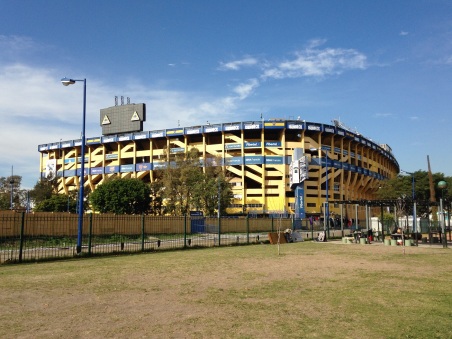Santiago’s Estadio Nacional is a pretty utilitarian-looking football stadium that was built from 1937-1938 in Municipality of Ñuñoa. A product of its time, It was modeled after Olympiastadion Berlin (opened in 1936). It has remained the national stadium for Chilean football since its opening. I had the chance to see it from the outside in June 2015.
The original capacity was around 48,000, which is actually roughly the same as today. In between, though, capacity rose to over 80,000 as it was expanded to host the 1962 FIFA World Cup. The installation of individual seats in 2000, a requirement for the World Junior Championships in Athletics, lowered capacity to 66,000. Later, following the closure of the stadium from 2009-2010 for renovations, capacity was ultimately lowered to 48,665. The renovations to modernize the stadium, including the addition of a roof over all seats, were not fully realized due to delays and the February 2010 earthquake. The stadium still does not have a state-of-the-art scoreboard (it only has one board, on the south end of the stadium). The record crowd for a match at the stadium is 85,268 from December, 1962 for a Primera Division match between Universidad de Chile and Universidad Catolica.

Estadio Nacional from Cerro San Cristóbal in Santiago
Beyond all the events hosted at Estadio Nacional, from the 1941 South American Championships (predecessor of the Copa America) through the 1962 World Cup and on to the Copa America last month, its history is a most notorious one. It was used as a massive detention center by the Pinochet government following their 1973 coup d’état. The use of the stadium as a prison and death camp for thousands is well documented and an inescapable tragic history when considering the stadium. It is amazing that it wasn’t torn down or deserted following its history but the continued use following the final defeat of the dictatorship is a triumph (Chile’s return to democracy was celebrated by thousands in a 1990 rally at the stadium) and serves as a memorial to the victims.
Aside: I learned after that there is a section of wooden benches behind the north end goal that go unoccupied and serve as a memorial to the brutal history as a concentration camp. Check out BBC’s World Service World Football episode on the Ghosts of Santiago.

Wooden benches – a memorial to the victims of the Pinochet dictatorship – are bordered in red
My visit to Chile coincided with the 2015 Copa America by coincidence. I had no plans to see any matches but as La Roja faced Mexico at Estadio Nacional, I couldn’t stay away from at least getting a taste of a match day. A friend I met at my hostel and I walked about 30 minutes to the stadium for the pre-game festivities. As expected it was electric. Due to heightened security, the lighting at dusk and the position of the stadium in a larger 64 hectare sporting park, it was tough to get any decent looks at the stadium or any appreciation of the architecture. It was certainly imposing, though, and I appreciated that the façade hadn’t changed in any of the renovations.

Estadio Nacional, under the spotlights for the 2015 Copa America
In the crowd off Av. Grecia, my friend and I quietly negotiated with scalpers. One man wanted 20,000 pesos for a pair – or so we thought. Turned out to be 200,000 pesos (or 300 USD). A little rich for our blood. We decided to make a long lap around the park and made acquaintances with a couple of students who were looking to sneak in. Hopefully they made it – we couldn’t risk it. The lap was long but the atmosphere was electric with many excited Chileans making their way inside to see their national team, led by Vidal, Sanchez, Medel, Bravo and Vargas. It was getting real dark but we passed through many fields – being used for parking – and the Polideportivo.
When we made it back to the main entrance our friend scalping tickets continued to barter. He was getting desperate. Finally, we got him down to the 20,000 pesos (30 USD) for a pair. Too good to be true we thought, but what the hell? We made the deal across the street – ostensibly to get away from security. But as soon as the money and tickets were exchanged, the guy hilariously ran onto a departing bus. We laughed and said “no way these are legit” but still hustled through the extensive corrals to the ticket scanners. Once there, we got the dreaded “ERROR” on the scanner. We put up a little fight claiming ignorance but ultimately had a good laugh with the crew working the tickets.

Damn!
It all ended well as we walked backed to a bar near our hostel and Plaza Italia to watch the match. We found a seat, had some Escoba’s and ate a meat-packed pizza. The match was bonkers, ending in a 3-3 draw. Still, young Chileans packed the Plaza and celebrated on the grass and the monument. It was an awesome time… until the Carabineros rolled in with water cannons. Still super fun in the madness of it all. Weeks later, Chile won the Copa America – their first – and, this time, the celebrations at Plaza Italia were not interrupted.
It was real cool to be at one of 18 stadiums to host a FIFA World Cup Final – and even though I didn’t to explore much, I wouldn’t trade the night for a chance to explore an empty Estadio Nacional on another day or for a ticket into a run-of-the-mill Primera match where the stadium is mostly empty.

Site of Brasil’s second World Cup triumph in 1962

















































